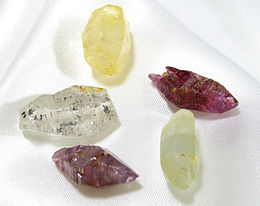Corrundum
| Corundum | |
|---|---|
 |
|
| General | |
| Category | Oxide mineral – Hematite group |
|
Formula (repeating unit) |
Aluminium oxide, Al 2O 3 |
| Strunz classification | 4.CB.05 |
| Dana classification | 4.3.1.1 |
| Crystal system | Trigonal |
| Crystal class | Hexagonal scalenohedral (3m) H-M symbol: (3 2/m) |
| Space group | R3c |
| Unit cell | a = 4.75 Å, c = 12.982 Å; Z = 6 |
| Identification | |
| Color | Colorless, gray, brown; pink to red, orange, yellow, green, blue, violet; may be color zoned, asteriated mainly grey and brown |
| Crystal habit | Steep bipyramidal, tabular, prismatic, rhombohedral crystals, massive or granular |
| Twinning | Polysynthetic twinning common |
| Cleavage | None – parting in 3 directions |
| Fracture | Conchoidal to uneven |
| Tenacity | Brittle |
| Mohs scale hardness | 9 (defining mineral) |
| Luster | Adamantine to vitreous |
| Streak | White |
| Diaphaneity | Transparent, translucent to opaque |
| Specific gravity | 3.95–4.10 |
| Optical properties | Uniaxial (–) |
| Refractive index | nω = 1.767–1.772 nε = 1.759–1.763 |
| Pleochroism | None |
| Melting point | 2044 °C |
| Fusibility | Infusible |
| Solubility | Insoluble |
| Alters to | May alter to mica on surfaces causing a decrease in hardness |
| Other characteristics | May fluoresce or phosphoresce under UV light |
| References | |
| Major varieties | |
| Sapphire | Any color except red |
| Ruby | Red |
| Emery | Black granular corundum intimately mixed with magnetite, hematite, or hercynite |
Corundum is a crystalline form of aluminium oxide (Al
2O
3) typically containing traces of iron, titanium, vanadium and chromium. It is a rock-forming mineral. It is a naturally transparent material, but can have different colors when impurities are present. These impurities are the presence of transition metals in the crystal structure of corundum. Corundum has two primary gem varieties, ruby and sapphire. Rubies are red due to the presence of chromium, and sapphires exhibit a range of colors depending on what transition metal is present. A rare type of sapphire, padparadscha sapphire, is pink-orange.
The name "corundum" is derived from the Tamil word Kurundam, which originates from the Sanskrit word Kuruvinda meaning ruby.
Because of corundum's hardness (pure corundum is defined to have 9.0 on the Mohs scale), it can scratch almost every other mineral. It is commonly used as an abrasive on everything from sandpaper to large machines used in machining metals, plastics, and wood. Some emery is a mix of corundum and other substances, and the mix is less abrasive, with an average Mohs hardness of 8.0.
...
Wikipedia
